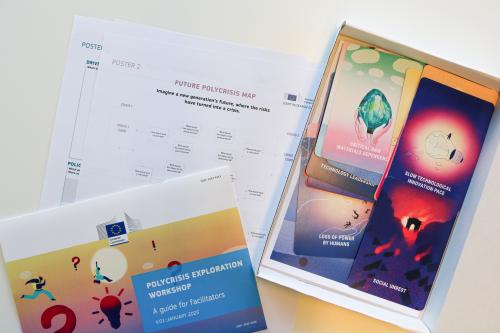Brief me
The Polycrisis Exploration Workshop facilitates strategic conversations about current and future risks, disasters, and polycrisis.
You can use this tool to:
Enhance risk awareness by exploring a broad spectrum of risks
Map future polycrisis and explore their interconnected and cascading impacts in your area of work
Identify policy interventions to mitigate risks.
Background
In today’s increasingly volatile world, risk is ever-present. Disasters and crises are growing more extreme and interconnected. This toolkit is a comprehensive guide to exploring 40 pre-identified risks with the possibility to add your own. It can be applied across all policy domains and areas of interest.
The tool draws on insights from the Risks on the Horizon foresight study which identified 40 future risks, clustered in ten categories. Collective intelligence exercises such as this can bring new knowledge and broader perspectives into policy making, sparking new ideas, and helping to co-create impactful interdisciplinary solutions. They complement traditional risk assessment - moving from understanding complex risk to managing it. The workshop aims to be accessible and can be a starting point for deeper analysis, enhancing EU preparedness.
How to use it
Risks and polycrisis are broad and complex and different groups have different interests in and goals for engaging. We have designed a 3-step workshop method to support strategic thinking, manage complexity, and ensure accessibility. To ensure a useful dialogue and maximise outputs, whilst balancing ambition with the reality of what a short foresight workshop can deliver, this format offers three types of activity:
Activity 1: Enhance risk awareness by exploring the broad spectrum of risks
Activity 2: Map future potential polycrisis and explore interconnected (cascading) impacts
Activity 3: Identify policy interventions to mitigate disasters and support policy goals
Customise Your Workshop:
We recommend that you do all three activities for more purposeful work and advise you to take enough time to do the exercises comfortably. Allow space for participants to engage in discussions that foster more conclusive, operational outputs.
The decision on where to focus your time and effort is based on the nature of your interest in risks, and your specific goals. Be realistic about time and objectives and customise the agenda accordingly. Here are some questions to help you decide:
If you want to discuss risks beyond the usual top 10 lists, explore assumptions and perspectives on them - include Activity 1.
Are you mainly interested in polycrisis and the interconnectedness of cascading impacts - prioritise Activity 2.
Do you want to identify core drivers of crises, and developments that might make crises more extreme in the future? Do you want to identify early preparedness intervention points that could reduce negative future impacts on your policy objectives? - prioritise Activity 3.
For more details consult the Facilitator’s guide

Illustrations by Julie Pernet.
Toolkit components
Download here the workshop materials:

